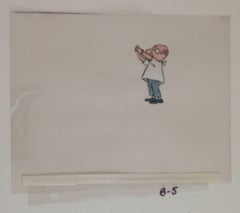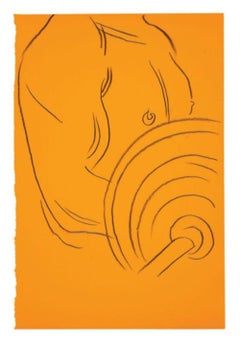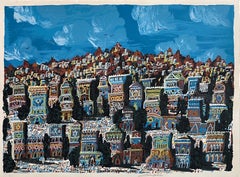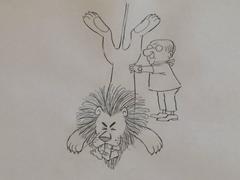Maurice Sendak Art
Dubbed by one critic “the Picasso of children’s literature” and once addressed by former President Bill Clinton as “the King of Dreams,” Maurice Sendak illustrated nearly a hundred picture books throughout a career that spanned more than 60 years. Some of his best known books include Chicken Soup with Rice (1962), Where the Wild Things Are (1963), and In the Night Kitchen (1970).
Born in Brooklyn in 1928 to Jewish immigrant parents from northern Poland, Sendak was a largely self-taught artist. His characters, stories, and inspirations were drawn from among his own neighbors, family, pop culture, historical sources, literary influences, and long-held childhood memories. Along with William Steig, Ludwig Bemelmans and Laurent de Brunhoff he is one of the most popular authors of children’s books in the world.
Sendak worked with such well-known children’s authors as Ruth Krauss, Else Minarik, and Arthur Yorinks, and illustrated books by Leo Tolstoy, Herman Melville, Isaac Bashevis Singer, the Brothers Grimm, and the poet Randall Jarrell. He began a second career as a costume and stage designer in the late 1970s, designing operas by Mozart, Prokofiev, Ravel, and Tchaikovsky, among others.
Sendak won numerous awards, including a Caldecott Award, the international Hans Christian Andersen Award, a National Book Award, the Astrid Lindgren Memorial Award, and a National Medal of Arts. His books continue to be read by millions of children and adults and have been translated into dozens of languages and enjoyed all over the world.
Find original Maurice Sendak prints, paintings and other art for sale on 1stDibs.
(Biography provided by Lions Gallery)
1990s Folk Art Maurice Sendak Art
Screen
1970s Pop Art Maurice Sendak Art
Watercolor
1970s Pop Art Maurice Sendak Art
Paper, Carbon Pencil
1970s Pop Art Maurice Sendak Art
Carbon Pencil, Paper
1980s Pop Art Maurice Sendak Art
Graphite, Paper
20th Century Folk Art Maurice Sendak Art
Screen, Lithograph
1940s Folk Art Maurice Sendak Art
Screen
2010s Folk Art Maurice Sendak Art
Woodcut, Screen
1940s Folk Art Maurice Sendak Art
Screen
1940s Folk Art Maurice Sendak Art
Screen
1940s Folk Art Maurice Sendak Art
Screen
1940s Folk Art Maurice Sendak Art
Screen
1940s Folk Art Maurice Sendak Art
Screen
1940s Folk Art Maurice Sendak Art
Screen
19th Century Old Masters Maurice Sendak Art
Paper, Carbon Pencil
1850s Old Masters Maurice Sendak Art
Paper, Carbon Pencil
1970s Pop Art Maurice Sendak Art
Carbon Pencil, Paper
1970s Pop Art Maurice Sendak Art
Carbon Pencil, Paper
1970s Pop Art Maurice Sendak Art
Carbon Pencil, Paper
1970s Pop Art Maurice Sendak Art
1970s Pop Art Maurice Sendak Art
1970s Pop Art Maurice Sendak Art
1970s Pop Art Maurice Sendak Art
1970s Pop Art Maurice Sendak Art
1970s Pop Art Maurice Sendak Art
Paper, Carbon Pencil
1970s Pop Art Maurice Sendak Art
Acrylic Polymer, Mylar
Maurice Sendak art for sale on 1stDibs.
Artists Similar to Maurice Sendak
- 1stDibs ExpertApril 5, 2022Maurice Sendak, an American illustrator and author, is best known for his universally beloved children’s book, Where the Wild Things Are. First published in 1963, the book was lushly illustrated with Sendak’s expressive, one-of-kind monsters. Shop a selection of original Maurice Sendak artwork from some of the world's top dealers on 1stDibs.




